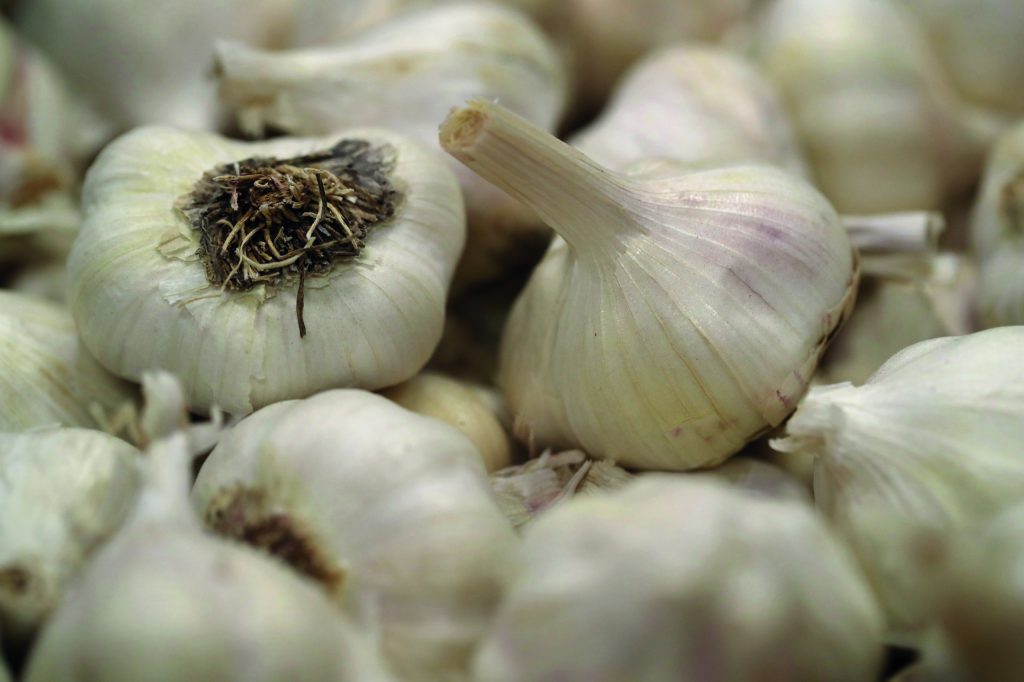‘A nickel will get you on the subway,’ the saying goes, ‘but garlic will get you a seat.’ Garlic’s always possessed a pungent reputation — according to the explorer Robert de la Salle, the area of modern-day Chicago was so full of Allium tricoccum, our native wild garlic, that the Algonquin called it Che-ka-kou, ‘place of the smelly onions’. But it was Lucky Leif Erikson who brought the first bulbs of Allium sativum, the kind of garlic you buy at the grocery store, to the settlements of Vinland in Newfoundland and along the shores of the Gulf of Saint Lawrence.
The Vikings didn’t remain chez nous, but garlic did, carving out a niche for itself as is its wont. It overcame centuries of upper-crust Anglo-Saxon disdain, exemplified by the poet Shelley, who on visiting Italy was horrified to see well-bred young ladies eating garlic without shame — and annoyed when his friend Byron joined in with gusto. But by the late 20th century, the odoriferous dainty had conquered American hearts and palates. A plethora of garlic farms, large and small, are now spread across the country, and many is the kitchen garden with a couple rows of ripening bulbs.
Garlic is easy to grow, they say. If you live in a cold climate, you plant your seed garlic — each clove oriented upright, stem to the sky — in the fall. All winter it slumbers in the frozen earth, and when spring beckons it bursts joyfully through the surface of the field in gorgeous green rows. But when we tried growing some, the garlic must have sensed we were amateurs. Nary a green stalk appeared when spring rolled around. Instead, a month’s worth of rain pooled in the field, as the garlic cloves sat comfortably below ground level, probably cracking jokes at our expense. We thought the water would drain off, but no: it sat cheerfully stagnant till June, openly flouting the laws of physics. Had we been aiming for a bumper crop of mosquitoes, we could have planned no better; passersby wondered audibly whether we were raising garlic or trout. The majority of our aspiring garlics never saw the light of day. Although a few eventually came up, it was one of those pyrrhic victories where the casualties so far outnumber the survivors that you’d burst into tears if you weren’t afraid of drowning them too.
But this tragic experience doesn’t seem to be common among garlic growers. Indeed, on the commercial level, garlic was a reliably profitable crop in America until the early 1990s, when China flooded the market with garlic far cheaper than anyone in North America could offer. Then, like all the other North American producers forced to compete with goods from the famously opaque People’s Republic of China, American garlic farmers suddenly had a lot of free time to scratch their heads and wonder how China could afford to grow garlic, ship it to North America and dump it on the market at a price that barely covered shipping costs.
Had the Chinese Communist party subsidized its growers? Did Beijing decide to sell Chinese produce at a loss in an attempt to undermine the North American economy? Yuan Yang, a Chinese correspondent for the Financial Times, reported in 2018 that as part of the forced-labor program in China’s jails, prisoners were made to peel vast quantities of garlic destined for the USA — which would render imports illegal. However that may be, American garlic farmers were thrilled last year when President Trump subjected Chinese garlic to heavy tariffs. Quality has also remained a concern with Chinese garlic — many unanswered questions have swirled over the last couple decades relating to nasty kinds of fertilizer, unhygienic processing practices and polluted soil. It’s also said to be common practice to bleach the bulbs before shipping, so that the consumer may be dazzled by their unnatural whiteness.
If you come across such whited sepulchers sitting in the grocery store, the only proper course of action is to demand North American garlic pronto. The two most widely grown commercial varieties in the United States are the creatively-named ‘California Early’ and ‘California Late’, softneck garlics that are generally blander in taste than the hardneck varieties you’ll find at your local farmers’ market. (No, there are no redneck varieties.) Supporting your local garlic producers won’t just let the Chinese Communist party know you’re onto them but will also bring flavorful and nutritious food to your table.
[special_offer]
A kiss may be just a kiss, but a garlic isn’t merely a garlic. In colder climates, the porcelain cultivar ‘Music’ is favored, a hot garlic that becomes deliciously sweet when cooked. (‘Music’ was the variety that came to a tragic end in our field, lending fresh poignancy to that song about ‘the day the music died’.) Many think Purple Stripe varieties, with their strong, complex flavors, are the best for roasting (if you haven’t tried whole roasted heads of garlic, you haven’t lived). Garlic aficionados tend to rate Rocamboles as the finest of all. Rocamboles love regions with real winters and are sweet, aromatic, only moderately hot and delicious raw. Crush or grate a few cloves, mix with olive oil and serve it with bread as an appetizer.
If you frequent local garlic vendors in early July, you may be lucky enough to encounter the delightful and under-appreciated garlic scape. The scape is the flower of the garlic plant. It is strikingly pretty, a glossy green tube that grows straight up from the bulb into a dramatic coil about two-thirds of the way up, culminating in a seed capsule with a long, pointed beak. Scapes are usually harvested early in the season so the plant’s energy can be devoted to the bulb. Like asparagus, young scapes are tender and possess a light garlicky flavor best brought out by sautéing or grilling. They make an excellent accompaniment to steak.
T.S. Eliot immortalized the vegetable rather obscurely in ‘Burnt Norton’ from Four Quartets: ‘Garlic and sapphires in the mud/ Clot the bedded axle-tree…’ Both garlic and gemstones come out of the earth; symbolically speaking, why shouldn’t they be discovered embedded together in the mud on the tractor axle of an old blue Ford? Life, after all, is better when it includes garlic and sapphires. Sapphires will get you admiration, but garlic will get you respect. And a seat.
This article is in The Spectator’s July 2020 US edition. Subscribe here to get yours

























